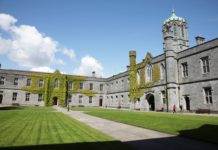Historian Brian Hanley writes on the history of the Irish Republican Congress
Nearly eighty years ago, left-wing republicans founded an organisation, which although short-lived, would leave a lasting effect on Irish socialism. The Republican Congress attempted to weld internationalism, socialism and patriotism into a dynamic force capable of organising Irish workers. The failure of their endeavour would condemn Ireland to further decades of conservative rule, but also holds important lessons for political activists today.
March 1934 saw the IRA split, with several of its best-known officers leaving and setting up a new organization – the Republican Congress. The reason for the schism was dissatisfaction among the IRA’s left wing about the organization’s lack of direction after two years of Fianna Fáil government. Peadar O’Donnell, a member of the Army Council and the best-known socialist in the IRA’s ranks argued that the army was drifting aimlessly while Fianna Fail was monopolizing republicanism.
Unless the IRA embraced social agitation – as O’Donnell argued it had done in the late 1920s – the organization would decline. Backed by George Gilmore and Frank Ryan, O’Donnell argued for a new congress of republican opinion combining representatives of the IRA, the rank and file of Fianna Fáil, Labour, trade unions and small farmers groups.
This would be an all-Ireland body that provide a rallying point for a new movement which would win back the slogan of ‘the Republic’ from Fianna Fáil.
At the IRA’s general army convention O’Donnell’s motion won the support of a small majority of delegates but was defeated by the votes of the Army Council and Executive. Mick Price, the IRA’s Director of Training, then moved a separate motion that the IRA pledge itself to remain in existence until a workers’ republic was achieved. This motion was also narrowly defeated. All four men left the convention and began to canvass support for a new organization.
In the weeks after the convention IRA officers from Offaly, Westmeath, Galway, Mayo, Leitrim and South Dublin added their names to the Congress proposal. Leading Cumann na mBan members also supported the move, as did Nora Connolly O’Brien and her brother Roddy (James Connolly’s daughter and son) and a number of labour and trade union figures. By May 1934, Congress had begun publishing its own newspaper edited by Frank Ryan and was organizing branches nationwide.
One of the groups affiliated to Congress was the Irish Citizens Army, which had been kept alive in Dublin by veterans of the 1916-23 period. An influx of ex-IRA volunteers gave the ICA a nationwide base, with units in Dublin, Cork, Belfast, Limerick and Kilkenny. Unlike the IRA, the Citizens Army, as it had in 1916, allowed women to became members and it urged all its volunteers to be active in working class politics as well as trained in arms: ’your skill with a rifle is not more important than your patience on a picket line nor are either of these more salient than your electoral activity’.
During the summer of 1934, Congress and ICA members were active in strikes and anti-fascist activity. Members were arrested raiding a strike-bound quarry in Bray and there were several clashes with Blueshirts. Congress involved itself in housing agitation and tenants’ struggles in Dublin and in land agitation in Achill.
North of the border, Congress allied itself with the Northern Ireland Socialist Party, a mainly Protestant organization that helped Congress to establish a presence on the Shankhill and Newtownards Road districts of Belfast. In June 1934, several dozen Protestant socialists from Belfast came to Bodenstown with the Republican Congress for the Wolfe Tone commemoration. They carried a banner bearing the slogan ‘Break the connection with capitalism’ – a photograph of which has become an iconic image on the republican left since then.
About 17,000 people attended Bodenstown that year, the vast majority of them IRA supporters. Prior to the event, the IRA had warned all political groups not to carry unauthorized banners, an order designed to enforce control over rivals like Congress. On the day, about 800 marched with Congress, led by the ICA carrying a Starry Plough flag. Congress supporters refused to put away their banners and IRA stewards moved to prevent them marching. Clashes broke out which saw the Shankhill Road banner torn in half as Congress supporters tried to force their way on to the parade. The incident caused much bad feeling, although at the time nobody claimed that it was the result anti-Protestant sectarianism. (The Communist Party complied with the IRA’s demands and were allowed march unmolested).
However, after its promising beginnings, at a meeting in Rathmines in September 1934, the Congress split over whether to carry on with a broad republican campaign as suggested by O’Donnell and Gilmore or become an openly socialist party as argued by Michael Price. O’Donnell and Gilmore believed that Congress should prove that both de Valera and the IRA had abandoned real republicanism. As O’Donnell put it: “My quarrel with de Valera is not that he is not a socialist, for he makes no pretence to be one. My quarrel with him is that he pretends to be a republican.”
For O’Donnell the struggle for the Republic and the breaking of the British connection would inevitably lead to the overthrow of capitalism. But Price and his supporters argued that to most people Fianna Fáil and the IRA did represent real republicanism and there was no way of winning back that ground. Instead the slogan of a Workers’ Republic clearly distinguished them from both de Valera and the IRA. It also identified to Protestants in the North the difference between the socialist idea of a republic and the IRA’s – ‘it is the phrase “Irish Republic” that separated us from the mass of workers in the north’ argued Nora Connolly O’Brien. With the support of communist delegates, O’Donnell’s side won the day at Rathmines and both factions went their own way amid much rancour – and undisguised glee from the IRA.
Though seriously weakened, the Republican Congress did not disappear after this split. It continued activity until 1936, working on unemployment and housing protests and organising an alternative Armistice Day event during November 1934 that brought together ex-British soldiers and republicans in protest against imperialism and war.
Price and his supporters would eventually join the Labour Party. Both Price and Roddy Connolly were largely responsible for getting the Labour Party to briefly adopt the Workers’ Republic as its objective in 1936. Lack of finance, condemnation from the Catholic Church and violent attacks by anti-communist mobs all contributed to Congress’ decline -although many had also been disillusioned by the in-fighting of 1934.
The last gasp of Congress was to organize support for the republican side in the Spanish Civil War during the summer of 1936. Leading activists including Frank Ryan travelled to Spain to fight alongside the International Brigades. Despite its failure, Congress was a real attempt to marry republican and socialist activity – the last serious attempt to do so until the 1960s.






Did the ICA continue after the Congress?
As far as I know the ICA were still about in some capacity until the mid 1940’s.
There was certainly an ‘old’ ICA group in the 1940s. But the split in 1934 left two factions (and i know this might seem farcical) one which was allied to Price and one to Connolly, and a lot of members who were in neither. The Gardai had fairly extensive files, which might point to infiltration. The ‘Labour News’ paper of the late 1930s carried ICA news and Mick Price was editor of Labour’s Torch in the 1940s.